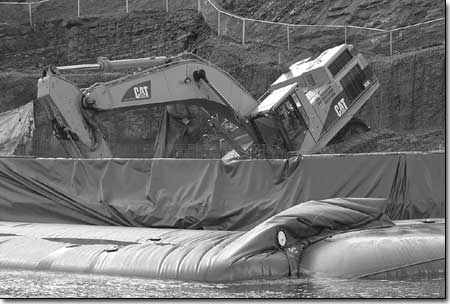|
Opponents charge that public process has been
violated
by Will Sands
 |
An earth mover works late last
year to excavate the pumping station for the Animas-La Plata
project. According to the Citizens’ Progressive Alliance,
an A-LP watchdog group, proponents of the project are trying
to return agricultural water to the deal, something that was
eliminated as part of the “A-LP Lite” compromise,
which was approved by
Congress in 2000./Photo by Todd Newcomer. |
As earth movers continue to expand a large hole on the edge of
the Animas River, opposition to the Animas-La Plata project is
continuing to work to stop the controversial diversion. After
a day in District Court last Friday, the opposition got an unwelcome
surprise and is now again fighting to halt efforts to return A-LP
to its former stature.
In 1968, A-LP was first authorized for construction by the U.S.
Congress as a way of fulfilling a century-old agreement with the
Southern Ute and Ute Mountain Ute Indian tribes. The agreement
endeavored to partly compensate the tribes for their losses with
water rights. When it was authorized, the A-LP project was proposed
as a diversion of water from the Animas and La Plata rivers to
a series of reservoirs in and around Ridges Basin. At the time,
A-LP’s purpose was to serve the tribes’ irrigation
and agricultural needs. However, courtesy of the Vietnam War,
that project was never built.
Since that first authorization, the project has seen numerous
challenges and revisions. In 2000, a scaled down version, coined
“A-LP Lite,” was again authorized by Congress. The
changed project included a 39 billion-gallon reservoir 2.5 miles
southwest of downtown Durango in Ridges Basin. A pumping plant
located near Santa Rita Park would siphon up to 280 cubic feet
per second from the Animas River and pump it uphill to feed the
reservoir. Water stored in the reservoir would no longer be used
for agriculture but would serve yet-to-be-determined municipal
and industrial needs in New Mexico and Colorado.
 |
The Animas River makes its way
ownstream from Durango. A-LP will draw up to 280 cfs from
the river and store it in Ridges Basin. According to the original
plan, approved by Congress in 2000, the water cannot be used
for agriculture, but a local water conservancy district is
making a move to
return ag water to A-LP./Photo by Todd Newcomer. |
The removal of the agricultural use was key to the authorization,
according to the Citizens’ Progressive Alliance, a watchdog
group opposing A-LP on many fronts. Namely, many objections, including
those of the Environmental Protection Agency, were directly tied
to water quality impacts from irrigation return flows. CPA attorney
Sunny Maynard said that it was revealed at last Friday’s
hearing that proponents are trying to put the pounds back on A-LP
Lite and bring agricultural use back into the picture.
The CPA was in District Court for the hearing on its charge that
the Bureau of Reclamation actually has no water rights for A-LP.
The case claims that the Bureau has failed to do its necessary
legal upkeep on the rights, also known as diligence, and consequently
has lost them. According to Maynard, this failure represents the
ultimate paradox – taxpayers are paying exorbitant sums
to build a project for which there is no decreed water.
Maynard said that last Friday, attorney Janice Sheftel an ardent
A-LP proponent, announced that the district planned to preserve
the potential for an agricultural component of A-LP. Sheftel is
a partner with Maynes, Bradford, Shipps & Sheftel, the general
counsel for the Southwestern Water Conservation District. She
concurred that the district would like A-LP to potentially serve
agriculture in the future, but said that many steps and processes
would have to be taken before it could happen.
“The desire of the Southwestern Water Conservation District
to preserve the ability of its members under Colorado law to use
water for irrigation in the future does not change the authorization
in the 2000 amendment that Animas-La Plata project water is currently
authorized only for municipal and industrial use,” she read
from a prepared statement. “When the A-LP project is completed
Congress would need to authorize any use of project water for
irrigation use.”
A case of Animas -La Plata
deja vu |
| This is not the first time the Citizens’
Progressive Alliance has fought against the revival of the
original Animas-La Plata project. Last summer, the group celebrated
a victory when an application to divert water through Ridges
Basin and into a new reservoir principally for agricultural
use was withdrawn.
In the year 2000, the La Plata Water Conservancy District
developed a Water Management and Conservation Plan for western
La Plata County, otherwise known as the Dry Side. An application
was filed in water court calling for the construction of
a reservoir in Long Hollow and diversion of up to 600 cubic
feet per second of Animas River water via Ridges Basin Reservoir
to feed Long Hollow Reservoir. The district claimed the
project was necessary because of increasing difficulty meeting
the needs of existing agriculture, growing residential development
and the demands of New Mexico under the La Plata River Compact.
At the time of application, current State Sen. Jim Isgar
was the president of the district. He is currently its vice-president.
The CPA actively fought the application in court, and in
late July of last year, it was withdrawn. At that time,
Isgar stated that the application was withdrawn because
of the objection and mounting court costs.
He also said that the application was an effort to improve
the situation on La Plata County’s dry-side. “It’s
funny that some of the environmental groups are opposed
to our improving the situation on the La Plata River,”
he said at the time. “Now we have a project that’s
entirely domestic water, and we’ve got farmers that
are having to sell out.”
|
Maynard countered that this desire is evidence that both the
U.S. Congress and U.S. public were deceived when A-LP Lite was
first offered as a compromise.
“At the time, there were tons of articles about the ‘Great
Compromise,’” Maynard said. “They are now claiming
just the opposite of what they told the Congress and the public
in 2000. We’re seeing these people just thumbing their noses
at the law.”
Phil Doe, CPA’s chair, agreed that Friday’s announcement
offered evidence of efforts to backdoor A-LP to its former might.
He said he found it particularly ironic given that A-LP Lite was
also pitched as a substantial cost savings for taxpayers. However,
the savings have not exactly piled up. Last summer, the Bureau
of Reclamation revealed $163 million in cost overruns and a 50
percent jump in A-LP costs to $500 million.
“First they knowingly lied, big time, about the costs of
the project so that Congress would fund it,” Doe said. “Now,
they spit in the face of Congress by renouncing what they promised
to give up. It’s time for Congress to step in and protect
the public from the appetites of this bunch.”
Maynard agreed, saying the move is the biggest effort to dodge
due process that she had seen in her 15-year experience in water
court.
“We’ve been in court for two years, and we’ve
been unable to drag one bit of information out of these people,”
she said. “Yet, the public’s money is being spent
by the truckload on a federal project that doesn’t even
yet have a water right.”
She added, “This is sheer insanity from the standpoint
of the common good.”
In conclusion, Maynard said that she is currently preparing a
motion to have agricultural use acknowledged as a forbidden use
of A-LP. “They are out of luck,” she said. “I
will file a motion so I can get a court judgment.”
|

